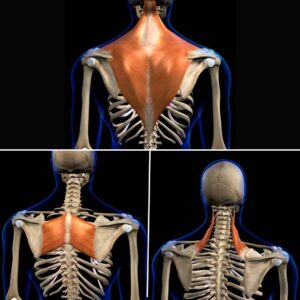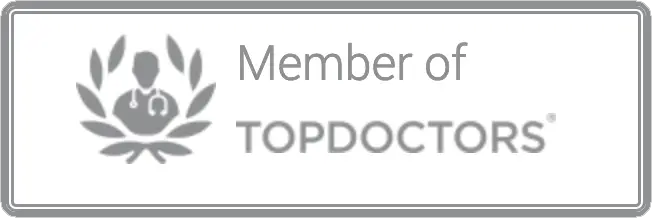 What is the shoulder blade?
What is the shoulder blade?
Shoulder blade pain is common. The medical name for the shoulder blade is the scapula. The scapula is a bone that sits at the back of the chest and forms two joints: the shoulder joint (between the humerus and the scapula) and the acromioclavicular joint (between the clavicle and the scapula). The shoulder joint socket (glenoid), and the acromion, are parts of the scapula. The shoulder blade has many muscles attached to it. The 4 rotator cuff muscles cover the front, top and back of the shoulder blade.
The shoulder blade is attached to the trunk by several muscles. The serratus anterior muscle holds the shoulder blade onto the chest wall. The trapezius muscle, levator scapulae, and rhomboid muscles help to move the scapula.
What are the causes of shoulder blade pain?
Shoulder blade pain is also referred to as scapulothoracic pain or scapular pain. There are several causes of pain in the shoulder blade. We will focus on the musculoskeletal causes in this blog.
Abdominal conditions such as gallstones, pancreatitis and even pregnancy can cause pain radiating to the shoulder blade. There is usually associated abdominal pain, and when there is an acute problem the shoulder blade pain can be severe. If you have acute severe painin your shoulder blade you should seek medical attention.
Musculoskeletal causes of shoulder blade pain include pain from sore muscles, pain from nerves, and pain from bony conditions.
Scapular pain from bony conditions is rare. Fractures of the shoulder blade are uncommon and usually are caused by high energy injuries. In rare cases, tumours in the shoulder blade can cause pain but these are thankfully uncommon. Intractable pain that is worse at night, tenderness over the shoulder blade, or any swelling over the shoulder blade should be checked out ASAP by your doctor.
Another rare cause of pain around the shoulder blade is nerve pain. Nerve pain from a trapped nerve in your neck or from a viral infection in your nerves can cause pain down the inner border of the shoulder blade. This pain is often severe and may be felt as a shooting or electric type pain.
The most common cause of pain around the shoulder blade is muscular pain. Muscular pain can result in pain at the top of the shoulder and base of the neck due to the trapezius muscle, or pain between the shoulder blade and the spine due to the rhomboids and the levator scapulae muscles. Weakness or fatigue in any of these muscles can cause pain.
Some common causes of muscle related scapulothoracic pain include:
- stiffness from a frozen shoulder or shoulder arthritis which can make the shoulder blade muscles over work to lift the arm,
- poor posture such as sitting at a computer or workstation with the shoulder blades slumped forward which puts the muscles under stretch,
- not taking work breaks which can make the muscles fatigue.
Patients with muscular scaoulothoracic pain can experience pain over and around the shoulder blade, at rest, after prolonged activities such as computer work and driving, and during sleep. For some patients laying on the affected shoulder is painful and even laying on the opposite shoulder can cause pain as the affected shoulder falls forward and the shoulder blade muscles come under stetch. Some patients can experience clicking under the shoulder blade as the muscles rub over each other in a uncoordinated way.
How to help shoulder blade pain?
There are some simple steps you can take to help with pain caused by muscles around the shoulder blade:
- Work on good shoulder posture holding your shoulder blades back and down rather than hunched up and forward.
- Ask your employer to undertake an ergonomic assessment of your home or office workstation to ensure you have the correct equipment and chairs, desktops, and computer screens are set at the right height for you.
- Take regular breaks during repetitive work so that you can change position, stretch your muscles, and warm them up before resuming work
- Do some simple exercises to strengthen your shoulder blade muscles.
Check out this video from our physiotherapy colleague Joy Ogude with some simple exercises you can do at your desk to help with scapular pain:
If your shoulder pain is severe, sudden onset, or not responding to these simple steps, you should seek medical advice. We would take a history and examine you and sometimes do tests such as x-rays or scans to help diagnose the cause of your pain. Sometimes painkillers are needed to help manage shoulder pain. You can find out more about using painkillers effectively here.
If the cause is confirmed to be muscular, we will refer you to a physiotherapist for a formal course of physiotherapy. Most muscular pain in the shoulder blade (scapulothoracic pain) will settle with a 12-week course of exercise-based physiotherapy. Patients can then use the exercises shown by the physio to self-manage if shoulder blade pain returns in the future.
The good news is that injections, and surgery are rarely needed for shoulder blade pain.
If you need help with managing your shoulder blade pain please get in touch to book an appointment.

 What is the shoulder blade?
What is the shoulder blade?



